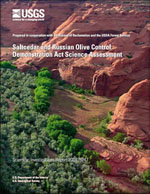The primary intent of this document is to provide the science assessment called for under The Saltcedar and Russian Olive Control Demonstration Act of 2006 (Public Law 109-320; the Act). A secondary purpose is to provide a common background for applicants for prospective demonstration projects, should funds be appropriated for this second phase of the Act. This document synthesizes the state-of-the-science on the following topics: the distribution and abundance (extent) of saltcedar (Tamarix spp.) and Russian olive (Elaeagnus angustifolia) in the Western United States, potential for water savings associated with controlling saltcedar and Russian olive and the associated restoration of occupied sites, considerations related to wildlife use of saltcedar and Russian olive habitat or restored habitats, methods to control saltcedar and Russian olive, possible utilization of dead biomass following removal of saltcedar and Russian olive, and approaches and challenges associated with revegetation or restoration following control efforts. A concluding chapter discusses possible long-term management strategies, needs for additional study, potentially useful field demonstration projects, and a planning process for on-the-ground projects involving removal of saltcedar and Russian olive.


